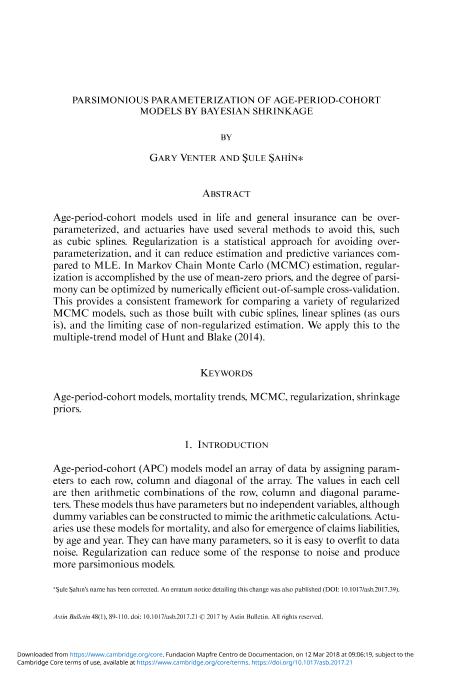Parsimonious parameterization of age-period-cohort models by Bayesian Shrinkage

Contenido multimedia no disponible por derechos de autor o por acceso restringido. Contacte con la institución para más información.
| Tag | 1 | 2 | Valor |
|---|---|---|---|
| LDR | 00000cab a2200000 4500 | ||
| 001 | MAP20180005602 | ||
| 003 | MAP | ||
| 005 | 20180320110250.0 | ||
| 008 | 180226e20180101bel|||p |0|||b|eng d | ||
| 040 | $aMAP$bspa$dMAP | ||
| 084 | $a6 | ||
| 100 | $0MAPA20180001970$aVenter, Gary | ||
| 245 | 1 | 0 | $aParsimonious parameterization of age-period-cohort models by Bayesian Shrinkage$cGary Venter, Sule Sahín |
| 520 | $aAge-period-cohort models used in life and general insurance can be overparameterized, and actuaries have used several methods to avoid this, such as cubic splines. Regularization is a statistical approach for avoiding overparameterization, and it can reduce estimation and predictive variances compared to MLE. In Markov Chain Monte Carlo (MCMC) estimation, regularization is accomplished by the use of mean-zero priors, and the degree of parsimony can be optimized by numerically efficient out-of-sample cross-validation. This provides a consistent framework for comparing a variety of regularized MCMC models, such as those built with cubic splines, linear splines (as ours is), and the limiting case of non-regularized estimation. We apply this to the multiple-trend model of Hunt and Blake (2014). | ||
| 650 | 4 | $0MAPA20080592042$aModelos matemáticos | |
| 650 | 4 | $0MAPA20080592011$aModelos actuariales | |
| 650 | 4 | $0MAPA20100065242$aTeorema de Bayes | |
| 650 | 4 | $0MAPA20080602437$aMatemática del seguro | |
| 700 | 1 | $0MAPA20160009699$aSahin, Sule | |
| 773 | 0 | $wMAP20077000420$tAstin bulletin$dBelgium : ASTIN and AFIR Sections of the International Actuarial Association$x0515-0361$g01/01/2018 Volumen 48 Número 1 - enero 2018 , p. 89-110 |

